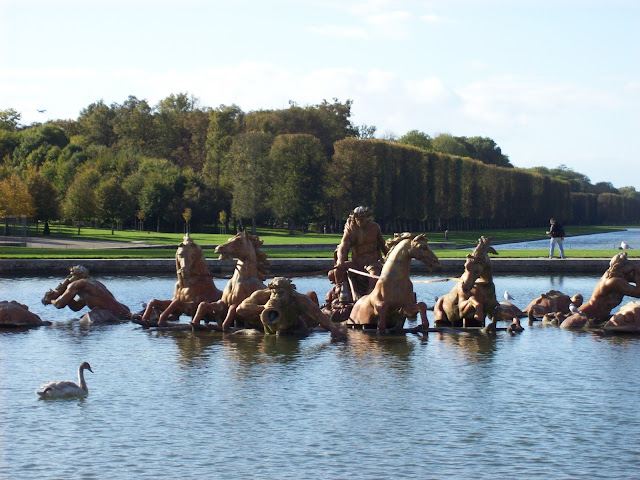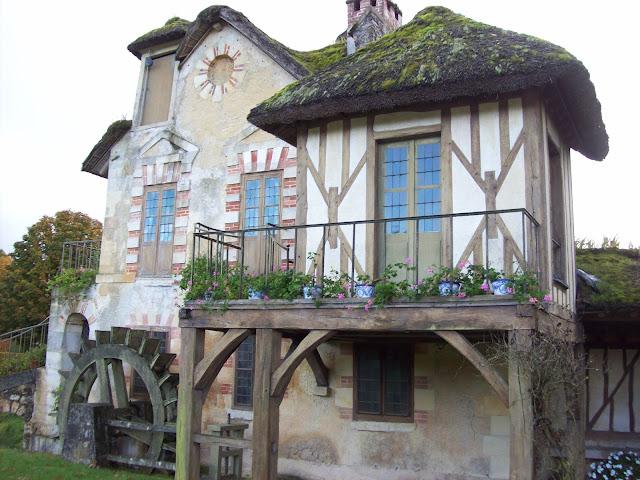After visiting the chateau of Chambord, we moved on
to Amboise where we checked into our beautiful French Manor for two
nights. We were off the next morning to
see the chateau of Chenonceau. . .in the rain! Here's a picture of our lodging in Amboise.
Although Chenonceau began as a castle in the 1400’s,
it wasn’t until the mid 1500’s when King Henry II gave the chateau to his
mistress that it became the unique bit of architecture that it is today. She added the arched bridge across the River
Cher to its opposite bank as well as the beautiful gardens surrounding the
chateau. [It’s bad enough that these
kings were so naughty, but some of them let everyone know how naughty they were
by giving their mistresses really nice houses to live in.] Chenonceau changed hands several times over
the years, but was known as the “ladies chateau” since the owners were
typically the mistresses or queens of kings.
The portion of the chateau that crosses the river was used as a wartime
hospital during WW I and over 2,000 wounded soldiers were treated there from
1916 to 1918. Some of the wounded fished
from the windows of the arched bridge to pass time.
The best way to share the beauty of Chenonceau and
the gardens is with pictures, so here you go…enjoy.
We arrived around noon on Friday in
Versailles. It took a few tries to
squeeze through the streets to our hotel, and even a tighter squeeze to get
into the parking garage. After dropping
off our bags, we headed for the Palace of Versailles which was right across the
street. Visiting Chambord and Chenonceau is a good way to prepare for the unbelievable sight of Versailles. One look at Versailles, with its rooms that
housed 10,000 aristocrats and servants, and you understand why Louis XVI and Marie Antoinette lost their
heads. The sheer size and amount of gold
leaf ornamentation is staggering.
However, the beauty of the architecture and art work contained in and
outside of the palace is exceptional.
And the gardens, filled with sculptures and fountains of every size,
stretch as far as the eye can see. Luckily, we caught a good sunny afternoon to
visit the extensive gardens.
In addition to the palace of Versailles, we visited
the Grand Trianon, which is a small palace in the back of Versailles built by Louis XIV to allow him to flee the stiff court
etiquette and spend time with his mistress (how naughty can you get….keeping
your mistress in the back yard). The
day we visited the palace, it was pouring rain and in the mid 50’s. While we thoroughly enjoyed the palace tour,
it was about a 20 minute walk from the palace to the Grand Trianon. The walk was wet, cold and windy. We stopped off for a hot lunch and a cappuccino at a crowded restaurant near the center of the gardens. It felt so good to be dry and warm for an
hour. Then it was off to the Grand
Trianon. This small palace was
beautiful in its own right, and was completely furnished in décor and furniture
of the period.
We also had tickets for Marie Antoinette’s hamlet,
which was a little farm village she had built in the back of Versailles where
she and her lady friends could pretend to live in the French countryside (this
was when she still had a head). While we
were searching for Marie’s hamlet, the sun came out. This really helped to lift our spirits and
dry our soggy clothes. It took a few
tries down various dirt paths in order to locate the hamlet within the huge
Versailles estate. However, it was worth
the effort. The village was just “too
cute.” Here are snapshots of Marie’s
farm village. By the way, farmers lived
in these little houses and grew vegetables that were used by the cooks in the
palace of Versailles.
Our next post will be our last two days with Diane in Paris.
Happy trails,
TNT












Yeah, quite the place...palace. Ha! We didn't have time to get to Marie's little estate, although I know that Jess did.
ReplyDeleteMuch better accommodations, by the way - nice chateau. I'm sure Diane has had a wonderful time - how could she not?
We will look forward to your Paris exploits.
Lee